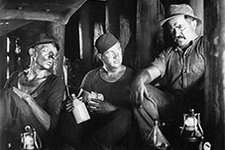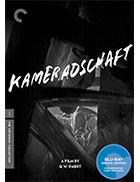Kameradschaft
|  G.W. Pabst's Kameradschaft (Comradeship) was inspired by an actual mining disaster that took place in 1906 in Courriéres near the Pas-de-Calais hills in northern France. It was, according to historian Roger G. Neville, "unprecedented and undoubtedly constitutes one of the world's worst recorded pit disasters." Nearly 1,100 men were killed after coal dust was ignited by open-flame lanterns, causing a massive explosion that collapsed much of the mine. The weeks-long rescue effort, which was enflamed by tensions between the miners and the Compagnie des Mines de Courrie, the company that owned the mine, was aided by a team of well-equipped German miners from Gelsenkirchen and Herne who, according to Neville, "were particularly adept at undertaking rescue operations in burning mines." And, while "they did not save any lives, … their presence did much to restore confidence, and they played an important role in the removal of bodies." The idea for a film based on this event was first suggested by Karl Otten, a renowned leftist poet, novelist, and broadcaster who recognized the event as a kind of microcosm of international worker solidarity, with German miners working side by side with their French brethren to try to save and then retrieve the fallen bodies of other miners, with the capitalist owners impeding progress as a means of saving money (they were accused of trying to seal off some tunnels to keep the coal there from igniting so it could later be mined). This sentiment was already well established, as conveyed by Richard Ernst in an essay published a month and a half after the disaster in the American periodical Advocate of Peace: it is as if the Germans had gained the greatest victory in their history, a victory not won by an immense army with sword and cannon, but by a single squad of twenty-one laborers, who displayed all the wonderful qualities so often claimed as a monopoly of the military hero, not in a work of destruction and hate, but in one of love and rescue. The five minutes of quiet march of these unassuming men from the railroad station at Billey-Montigny to the entrance to Shaft No. 2 seemed to bring order into the chaos, the light of hope to utter despair. The screenplay was eventually co-written by Ladislaus Vajda one of Pabst's regular collaborators who had previously co-written Pandora's Box (1929), Westfront 1918 (1930), and Threepenny Opera (1931); Peter Martin Lampel, who had contributed some uncredited writing on Westfront 1918; and Gerbert Rappaport, who had previously worked as an assistant director on 10 of Pabst's films (there was also uncredited work done by novelist and playwright Anna Gmeyner, whose play An Army Without Heroes, based on the Scottish miners' strike of 1926, had premiered in Berlin the year before). However, the screenplay's overall structure and intent clearly bears the impact of Otten's pacifist sensibilities (he had been arrested and held by the German government on the eve of World War I for distributing anti-war leaflets). At some point during the script-writing process, the action was shifted from 1906 to the present tense of 1931, more than a decade after the signing of the Treaty of Versailles ended the first world war (and forced Germany to paid extensive reparations). Thus, tensions between the Germans and the French were particularly intense, and borders were being policed with heightened authority. The influence of 1920s Soviet cinema is woven throughout Kameradschaft, not just in its narrative emphasis on worker solidarity trumping national boundaries and long-standing enmities, but in the lack of a central protagonist (something Pabst had experimented with a year earlier in his anti-war combat film Westfront 1918) in favor of a collective protagonist. It is easy to lose track of the various individuals throughout the film, as much of the focus is on the larger context of the mine disaster and the struggle for survival. We recognize individual characters, both the trapped French miners and the Germans who bravely cross the border to volunteer their expertise and possibly their lives, but mainly as types. There is an important scene early on in which three of the German miners who will volunteer to help-Kasper (Alexander Granach), Wilderer (Fritz Kampers), and Kaplan (Gustav Püttjer)-gather at a dance hall after unsuccessfully trying to get work in the French coal town, and one of them is turned down by a French woman when he asks her to dance, which he interprets as a rejection of his being German (she says that she is just tired, and probably is). It's a slight social injury, albeit one that is enflamed by the simmering tensions between the two nationalities and a reminder of how such enmity pervades not just politics, but social decorum and otherwise unrelated human interaction. Thus, the decision by the German miners, led by the determined Wittkopp (Ernst Busch, a dedicated communist in real life) to risk their own lives to help the trapped French miners takes on additional gravity. "We're all miners" is a unifying refrain heard repeatedly throughout the film. As with Westfront 1918, which plays as a kind of companion piece, Kameradschaft benefits substantially from Pabst's intense focus on realism, both physically and psychologically. The scenes inside the collapsed mine, which were shot entirely on a constructed set inside a zeppelin hangar-turned-studio outside Berlin, convey a sense of claustrophobic intensity that is palpable (the exteriors were shot on location in the Ruhr region, thus making use of the extensive industrial landscape of brick walls, towering factories, massive belching smokestacks, and housing complexes). The collapsing beams, piles of rock and coal, and chest-deep pools of oily water combine to create a hellish landscape from which it seems there can be no escape. Pabst's realism extends beyond the confines of the mine, though, and he interweaves it with clearly symbolic framing, such as when the German miners ask the foreman and mine manager for permission to use equipment in the rescue effort, and they are framed several steps below on a staircase, thus accentuating their precarious position vis-à-vis the company owners and managers (the original screenplay was even more aggressive in dividing the characters along manager-worker lines). Similarly, Pabst stages the film's turning point, when the German miners hear about the French mine collapse and resolve to do something about it, in a massive shower room when dozens of naked men, stripped of their protective gear, scrub the day's coal dust and grime off their own and each other's bodies. It's a striking sequence of literally naked camaraderie that is temporarily threatened by tempers, as some of the German miners rebuke any call to help their supposed enemies across the border. Such moments pave the way for the film's conclusion, which is both didactic in its rousing speechifying about the importance of everyone coming together not just in times of need, but always, and deeply pessimistic in conveying how all the good words and deeds in the world can't stop the barriers that were torn down from being resurrected again to ensure that everything is "in order."
Copyright © 2018 James Kendrick Thoughts? E-mail James Kendrick All images copyright © The Criterion Collection | |||||||||||||||||||||||||||||||
Overall Rating: 


 (3.5)
(3.5)


